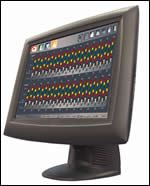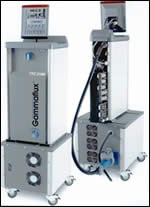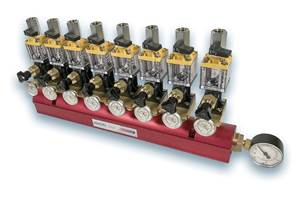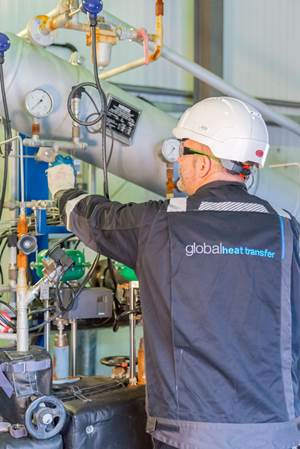NPE 2003 News Wrap-Up: Hot-Runner Temperature Controls
Sophisticated hot-runner temperature controls introduced at the NPE show in Chicago store set-up data right on the mold, detect (and even fix) thermocouple wiring mistakes, and employ easier-to-use icon-based displays.
Sophisticated hot-runner temperature controls introduced at the NPE show in Chicago store set-up data right on the mold, detect (and even fix) thermocouple wiring mistakes, and employ easier-to-use icon-based displays. At the same time, several lower-cost, “entry-level” controllers made their debut.
Plain or fancy?
American MSI Corp. rolled out a lower-cost, entry-level companion to its year-old Altanium control system. Instead of up to 384 zones of control, the new Altanium C series has up to 12 zones. It provides two zones of control per card, whereas the higher-end models have an independent control and power card for each zone. It is priced at $2650 for six zones and $3500 for 12 zones.
The new C series can be mounted directly on a D-M-E or American MSI junction box. The series comes in a mold-mounted (CM) version that leaves space for automation and hose connections while eliminating power and thermocouple cables. There is also a free-standing (CF) design that can fit into narrow spaces near the molding press.
Despite its lower cost, the C series still packs plenty of software features. These include Active Reasoning Technology (ART) that automatically self-tunes the control algorithms. Its UniStart software manages mold temperatures from warm-up to steady-state so as to eliminate uneven thermal expansion that can cause leakage and mold or thermocouple damage. Intraview diagnostic software tests the voltage delivered to each heater and also detects open, reversed, or pinched thermocouples and blown fuses and heaters. It can perform “soft rewiring” of some faults. It also measures the resistance and wattage for each heater to permit cavity-to-cavity thermal analysis and calculates total mold-energy usage.
American MSI released a new operator interface for the C-Series, called the Neo. It’s a monochrome touchscreen with graphical symbols. It shows setpoint and actual temperatures, power output, zone slaving, and alarms.
The company also introduced a new high-end interface for the original Altanium systems. This new Matrix system has a large LCD touchscreen (12 to 18 in.) with graphical icons and pull-down menus for access to numerous control, monitoring, and diagnostic functions. The control keeps a running log of all process changes with time and date stamp. SQC data recording, an online mold library, and remote monitoring capability through a wired network or internet browser are all standard. It operates in a Windows or Linux environment.
Chip off the mold block
Fast Heat brought out the Pulse II hot-runner control with Mold IQ—the ability to retrieve mold set-up data and operating history from a microprocessor chip embedded in the mold wiring box. “Currently, as a mold moves from one machine to another, all the information required for running the mold is lost,” says John Stojka, v.p. of business development. The Mold IQ chip stores such data as the tool name, operator name, machine number, material type, lot number, pressure and time settings, and barrel temperature, as well as hot-runner control settings, zone designations, power inputs, setpoint and actual temperatures, and operating modes.
As compared with earlier Pulse systems, the capacity has been expanded from 24 up to 180 zones. Like the earlier models, it uses hot-swappable modules that control two zones at a time. However, Pulse II also features a one-step diagnostic function that analyzes the status of hot-runner components with one touch of a button. It also has auto-tuning ability and software to optimize peak energy usage. A new 10-in. color display allows users to view all control zones from one screen interface. Its icon-based graphics ease programming and monitoring tasks. The system also uses a new Smart Mold Box that contains the wiring with a new Active Thermocouple Protection (ATP) circuit to prevent premature thermocouple failure.
Fewer zones, less cost
The latest from Gammaflux is the GLC-NE, a simpler, lower-cost, non-expandable temperature controller for up to six zones. It costs 20% less than the company’s 36-zone GLC series and has been available only in Asia until now. It retains the GLC’s proprietary PID2 control algorithms, as well as current measurement, operating limits, and security levels.
Gammaflux also announced a new full-featured but lower-cost option for its TTC line of hot-runner controls. A new international interface based on the GLC system can be substituted for the standard touchscreen. The new interface for this Windows NT system handles up to 128 zones instead of the usual 256 but retains virtually all of the TTC software features (e.g., operating limits, security levels, material protection, and troubleshooting) at a cost savings of about 50%.
Meanwhile, Gammaflux introduced version 2.0 software for the TTC controller that adds several new capabilities. It is now possible to “daisy chain” one TTC controller to another using one touchscreen interface, allowing up to 640 zones of control. It also has remote monitoring capability through an Ethernet network, new software that detects cross-wired zones in a mold, and automatic creation of performance reports at programmed intervals. The unit can be mounted within a molding machine’s control panel.
Ewikon’s new HPS C controller comes in three models—a 230V version with up to 36 zones, a universal model with up to 12 zones and either 5V or 230V output, and a PC touchscreen supervisory interface for controllers handling up to 160 zones. All models use self-tuning PID control to maintain temperature within ±1° C. An “intelligent start-up” function determines whether there is current leakage and operates the system in a normal or soft-start mode. The controllers have mold diagnostics and storage capacity for up to four mold set-ups.
Mounted on swivel arms, the touchscreen supervisory control also provides event and error reporting functions as well as data recording. Control keys in the monitor housing offer quick access to frequently used functions. The LCD color display monitors up to 40 zones per page. Each zone shows actual and set temperatures, deviation, and power output. Single zones or groups of zones can be selected with one touch for input or change of setpoints.
Ewikon also launched the Multi 5 series, a basic 230V controller for five, 10, or 20 zones.
Incoe replaced its series 760 controller with the full-featured but lower-cost Microcom II. It is a simple controller for up to 48 zones, using single-zone modules that can be easily swapped and replaced. Features include self-tuning, soft start, reversed thermocouple detection, and user-selectable time- or voltage-proportioning control.
More new choices
D-M-E’s new Integrity series of hot-runner controls, scheduled for commercial introduction next year, will feature new modules, new mainframes, new cabling, and ability to control hundreds of zones. The control modules are less than half the size of current Smart Series modules. A new front panel has a four-digit display of actual and set temperatures. The mainframes are offered in 12-zone increments. A patent-pending cable design reportedly enables error-proof connection. Other features include group or individual setpoints, stand-by heating, automatic mold-wiring diagnostics, and zone slaving.
A controller for up to 196 zones with 24V or 240V bushings is new from Plasthing. The company offers the unit here through an exclusive agreement with EFI Ltd., a U.K. maker of microprocessor temperature controllers specifically for hot runners. Features include real-time graphs of temperature and power, ability to change the control zones to mirror positions of the cavities in the mold, and an auto-test feature that checks that all the zones are correctly wired. It warns of incorrect connections between thermocouple and power source. The controller also has the patented Tool Guard, which monitors water cooling in the mold and automatically shuts down the hot-runner system in case of a cooling failure. Users can download program upgrades from a PC.
Mold-Masters announced several developments in its TempMaster series, which was unveiled last year in configurations for 24, 84, and 160 zones. The TMMZ line now comes in a machine-direct-mount (MDM) version, a new mini-graphical (MG) system, and a new sequential valve gate controller (SVGC). The MDM version has a magnet-mount LCD or TFT touchscreen display and an adapter for mounting the controller on the machine platen. The new MG system provides a graphical user system in a cost-effective package. It is said to provide the benefits of the firm’s more sophisticated TMMZ-G system but is limited to 24 or 60 zones. Features include auto ground-fault detection and wireless networking capability. Mold-Masters also added a sequential valve-gating option that delivers complete temperature and filling control in a single package.
Related Content
Is Your Water System Setup Helping or Hurting Your Molding Plant Productivity?
The plant water system is a critical component of an injection molding facility. A poorly designed or maintained water-cooling system can have a serious impact on production efficiency and cause many maintenance issues. Here’s what you need to know — and ask — to prevent those problems.
Read MoreACS Group Adds Regional Sales Manager
Richard Gutierrez named Southwest regional sales manager.
Read MoreFollow These Best Practices When Working With Heat Transfer Fluids
Effectively choosing, operating and maintaining thermal fluid can positively impact productivity in plastics processing.
Read MoreFree Cooling Chiller System Launches
Delta T Systems enters the free cooling space with a line that uses ambient air to cool the process fluid.
Read MoreRead Next
Lead the Conversation, Change the Conversation
Coverage of single-use plastics can be both misleading and demoralizing. Here are 10 tips for changing the perception of the plastics industry at your company and in your community.
Read MoreSee Recyclers Close the Loop on Trade Show Production Scrap at NPE2024
A collaboration between show organizer PLASTICS, recycler CPR and size reduction experts WEIMA and Conair recovered and recycled all production scrap at NPE2024.
Read MoreMaking the Circular Economy a Reality
Driven by brand owner demands and new worldwide legislation, the entire supply chain is working toward the shift to circularity, with some evidence the circular economy has already begun.
Read More

















